_____________________
Designing nanomedicine for therapy and imaging
This line of research aims to prepare injectable intelligent nanomedicines for cancer therapy, anti-inflammatory and neuroprotective therapies, and to develop theranostic agents combining diagnosis and treatment.
Formulation strategy for therapeutic nanocrystals – Y. Corvis
The nanoscale formulation of the active substance offers numerous advantages, such as targeted, prolonged delivery to the tissues of interest. The nanocrystalline form is particularly interesting for concentrating poorly soluble active substances (BCS classes II and IV) in pathological areas. UTCBS’s knowledge of drug physics and chemistry, combined with its expertise in nanomedicine, has enabled us to set up this innovative interdisciplinary project, which fits in perfectly with the interests of the team and the research unit, by proposing an original scientific approach. The proof-of-concept was established in partnership with our clinical partners at the Institut Gustave Roussy, who regularly encounter stabilization problems with their etoposide formulations in oncology. In an initial study, we demonstrated an improvement in the pharmacokinetics of etoposide in nanocrystalline form, and an improvement in its antitumor efficacy compared with the reference commercial form, Toposar®. Finally, by innovating in the protocol for obtaining these nanocrystals, a patent was filed in 2020. Since then, we have been able to demonstrate that the process can be generalized to other active substances of interest, leading to numerous international and national collaborations. The figure below highlights an example of a strategy for formulating and evaluating an anti-angiogenic therapeutic agent.
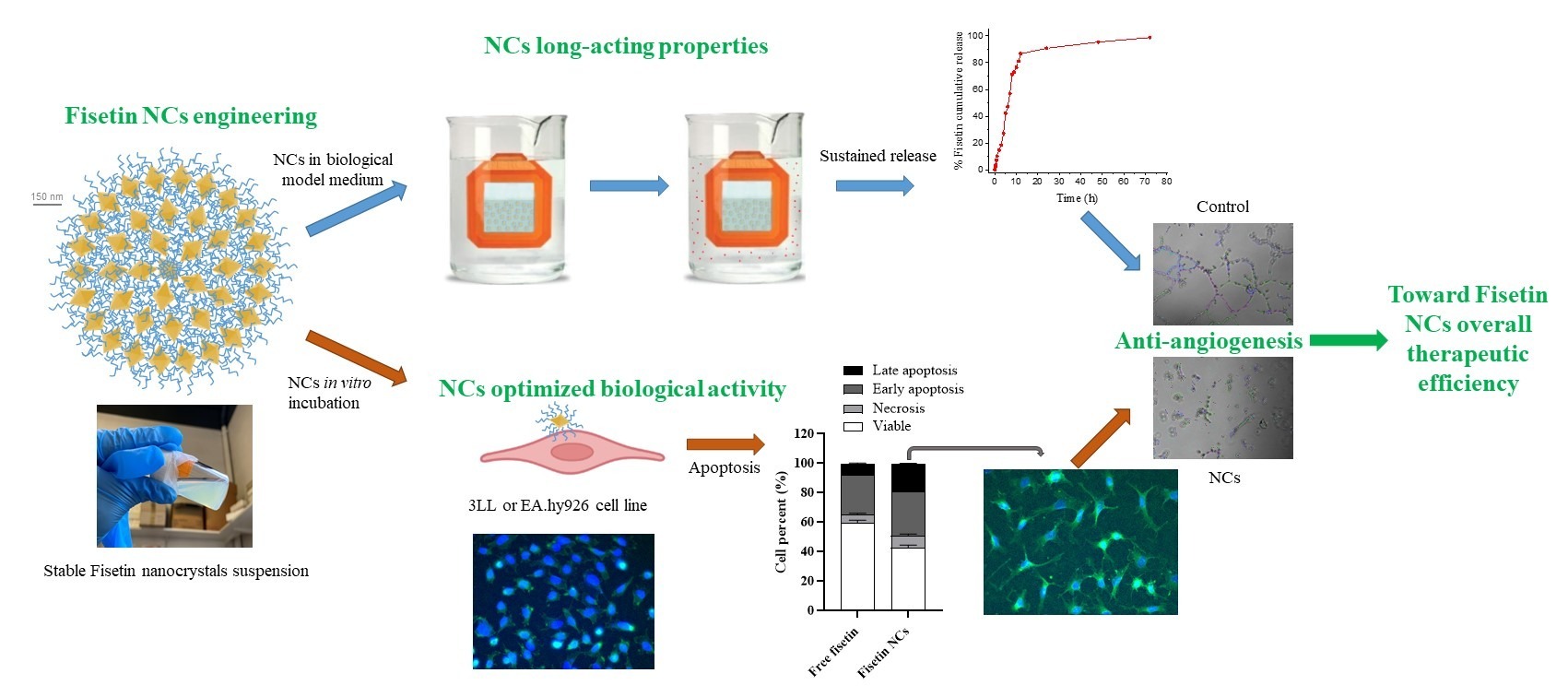
Formulation and evaluation strategy for an anti-angiogenic therapeutic agent: fisetin
Publications :
E. Lepeltier, V. Levet, T. Lee, N. Mignet, J. Shen, H. Fenniri, Y. Corvis. Editorial: Supramolecular nanomaterials for engineering, drug delivery, and medical applications. Front. Chem., 2020, 8, 626468. https://doi.org/10.3389/fchem.2020.626468
B. Martin Couillaud, P. Espeau, N. Mignet, Y. Corvis. State of the art of pharmaceutical solid forms from crystal property issues to nanocrystals formulation. ChemMedChem, 2019, 14, 8-23. https://doi.org/10.1002/cmdc.201800612
B. Martin, N. Mignet, Y. Corvis. Preparation of nanosuspension comprising nanocrystals of active pharmaceutical ingredients with little or no stabilizing agents. PCT Int. Appl. (2020), WO 2020043735 A1 20200305. https://patents.google.com/patent/WO2020043735A1/en
B. Martin, J. Seguin, M. Annereau, T. Fleury, R. Lai-Kuen, G. Neri, A. Lam, M. Bally, N. Mignet, Y. Corvis. Preparation of parenteral nanocrystal suspensions of etoposide from the excipient free dry state of the drug to enhance in vivo antitumoral properties. Sci. Rep., 2020, 10, 18059. https://doi.org/10.1038/s41598-020-74809-z
P. Ma, J. Seguin, N. K. Ly, L. Castillo Henríquez, E. Plansart, K. Hammad, R. Gahoual, H. Dhôtel, C. Izabelle, B. Saubamea, C. Richard, V. Escriou, N. Mignet, Y. Corvis. Designing fisetin nanocrystals for enhanced in cellulo anti-angiogenic and anticancer efficacy. Int. J. Pharm.: X, 2022, 100138. https://doi.org/10.1016/j.ijpx.2022.100138
Persistent luminescence nanoparticles for in vitro diagnostics and medical imaging- C. Richard
Persistent luminescence (PersL) is the property of some materials that can emit light for a long period (minutes, hours) after the end of their excitation. Such materials are mainly used for night vision. Since several years, our lab has been using this property to develop new chemical nanoprobes (PLNPs) for bio-imaging. By correctly choosing the inorganic precursor salts and the preparation method, it is possible to synthesize nanoparticles with PersL properties and with excitation and emission wavelengths that are well suited to bio-imaging. In addition, by working on the surface modification, using appropriate molecules and by developing reaction methods, it is possible to improve the colloidal stability of PLNPs and impact their applications. For example, we have shown that it is possible to use such nanoparticles for in vivo imaging in small animals. The PersL property makes it possible to obtain images with a high signal-to-noise ratio, unlike most fluorescent probes, and the surface coating makes it possible to modify their tropism. Moreover, We have recently shown that these nanoparticles may also be of particularly interesting for the development of in vitro biosensors based on amplification of the PersL signal in the presence of H2O2.
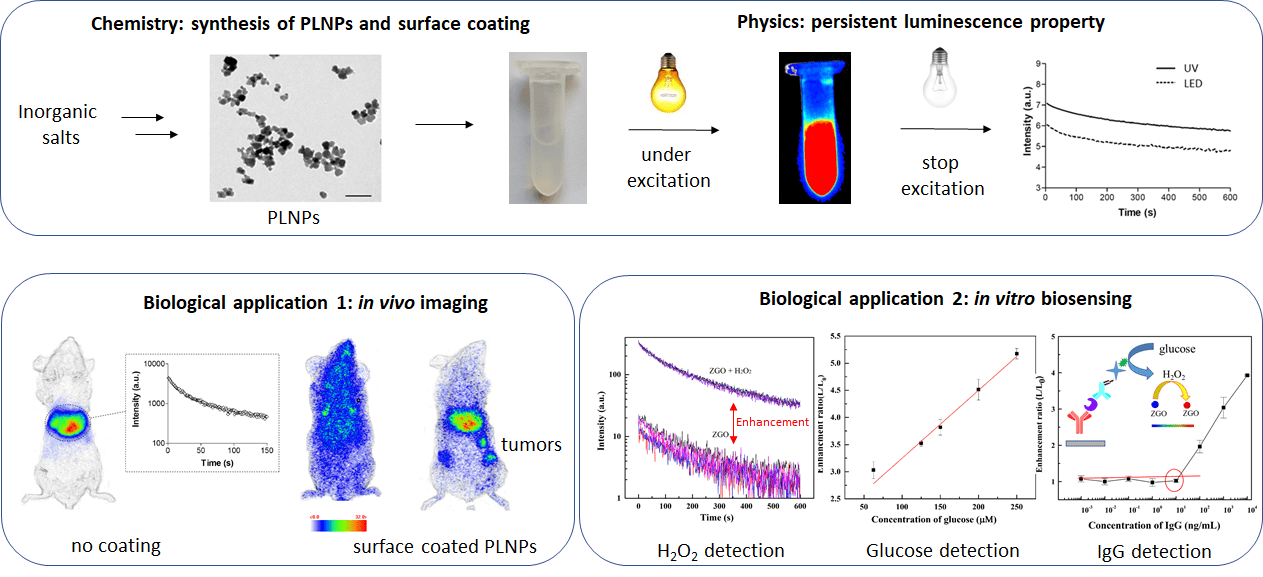
Maldiney, A. Bessière, J. Seguin, E. Teston, S. K. Sharma, B. Viana, A. J.J. Bos, P. Dorenbos, M. Bessodes, D. Gourier, D. Scherman, C. Richard. The in vivo activation of persistent nanophosphors for the optical imaging of vascularization, tumors and grafted cells. Nature Materials 2014, 13, 418-426. DOI: 10.1038/nmat3908
Maldiney , B.-T. Doan , D. Alloyeau , M. Bessodes , D. Scherman , C. Richard. Gadolinium-doped persistent nanophosphors as versatile tool for multimodal in vivo imaging. Advanced Functional Materials 2015, 25, 331-338. DOI: 10.1002/adfm.201401612
Lécuyer, E. Teston, G. Ramirez-Garcia, T. Maldiney, B. Viana, J. Seguin, N. Mignet, D. Scherman, C. Richard. Chemically engineered persistent luminescence nanoprobes for bioimaging. Theranostics 2016, 6, 2488-2524. DOI: 10.7150/thno.16589
Teston, T. Maldiney, I. Marangon, J. Volatron, Y. Lalatonne, L. Motte, C. Boisson-Vidal, G. Autret, O. Clément, D. Scherman, F. Gazeau, C. Richard. Nanohybrids with magnetic and persistent luminescence properties for cell labelling, tracking, in vivo real-time imaging and magnetic vectorization. Small 2018, 14(16):e1800020. DOI: 10.1002/smll.201800020
Liu, T. Lécuyer, J. Seguin, N. Mignet, D. Scherman, B. Viana, C. Richard. Imaging and therapeutic applications of persistent luminescence nanomaterials. Adv Drug Deliv Rev, 2019, 138, 193-210. DOI: 10.1016/j.addr.2018.10.015
Liu, L. Kotrchová, T. Lécuyer, Y. Corvis, J. Seguin, N. Mignet, T. Etrych, D. Scherman, E. Randárová, C. Richard. Coating Persistent Luminescence Nanoparticles with Hydrophilic Polymers for In Vivo Imaging. Front. Chem, 2020 doi: 10.3389/fchem.2020.584114. DOI: 10.3389/fchem.2020.584114
Lécuyer, N. Bia, P. Burckel, C. Loubat, A. Graillot, J. Seguin, Y. Corvis, J. Liu, L. Valéro, D. Scherman, N. Mignet, C. Richard. Persistent luminescence nanoparticles functionalized by polymers bearing phosphonic acid anchors: synthesis, characterization, and in vivo behavior. Nanoscale 2022, 14, 1386-1394. DOI: 10.1039/d1nr07114a
Lécuyer, J. Seguin, A. Balfourier, M. Delagrange, P. Burckel, R. Lai-Kuen, V. Mignon, B. Ducos, M. Tharaud, B. Saubaméa, D. Scherman, N. Mignet, F. Gazeau, C. Richard. Fate and biological impact of persistent luminescence nanoparticles after injection in mice: a one-year follow-up. Nanoscale 2022, 14, 15760–15771. DOI: 10.1039/d2nr03546d
Giordano, C. Cai, J. Liu, L. Carvalho Veloso Rodrigues, C. Richard, B. Viana. Persistent luminescence induced by upconversion: an alternative approach for rechargeable bio-emitters. Adv Opt Mater 2023, 2201468. DOI: 10.1002/adom.202201468
Liu, B. Viana, N. Mignet, D. Scherman, Y. Liu, C. Richard. H2O2-Induced Persistent Luminescence Signal Enhancement Applied to Biosensing. Small 2023, 2303509. DOI : 10.1002/smll.202303509
_____________________
Also to read
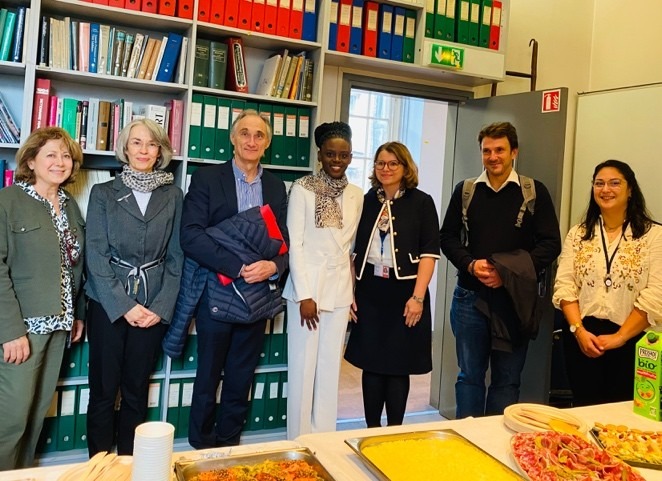
October 2025 – Thesis defense at UTCBS: Mitta PIERRE
On October 1st, 2025, Mitta PIERRE successfully defended her doctoral thesis entitled “Nanoformulations of antioxidant active ingredients for ophthalmic administration in the prevention of age-related macular degeneration (AMD)” supervised by Pr. Christine CHARRUEAU and co-supervised by Dr. Diana LAMAA
September 2025 – [Keynote research] Nathalie Mignet,Head of Laboratory, Nanomedicines and lipid nanoparticles for nucleic acid delivery
[Keynote research] Nathalie Mignet, Nanomedicines and lipid nanoparticles for nucleic acid delivery
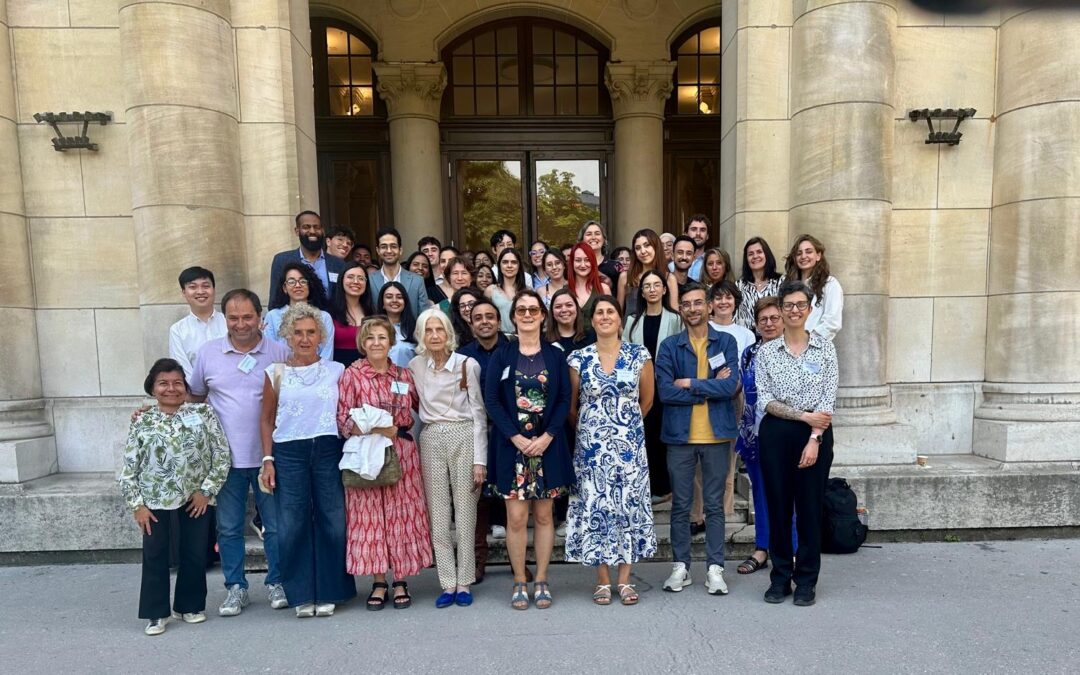
July 2025 – Workshop du master erasmus mundus Nanomed
Workshop du master erasmus mundus Nanomed
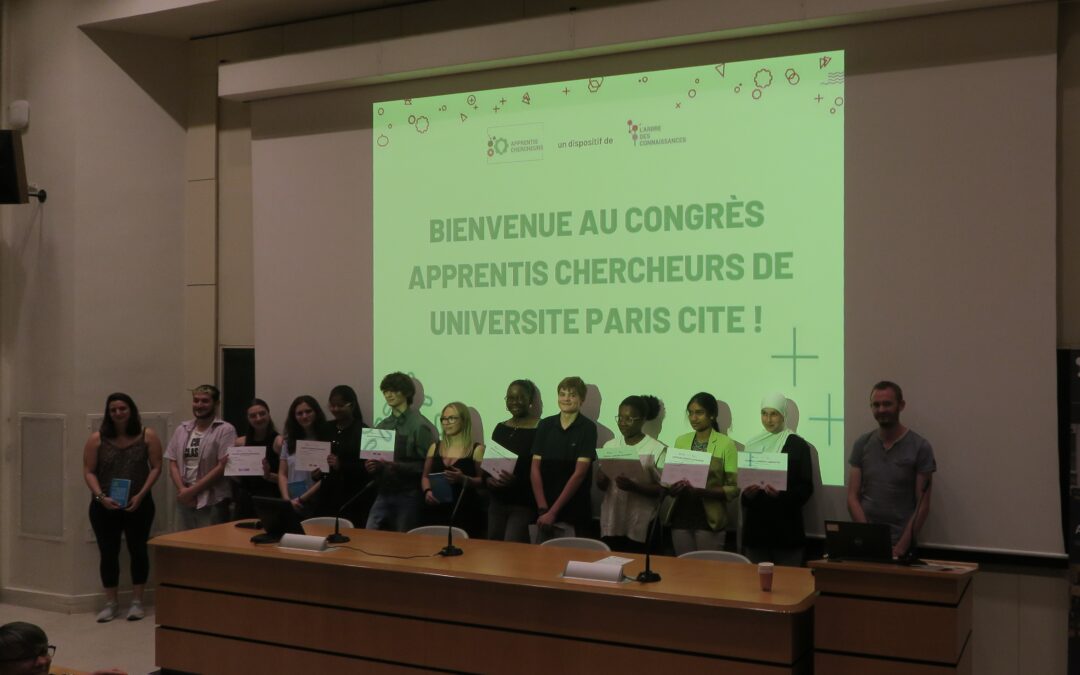
June 2025 – Université Paris Cité’s Apprentis Chercheurs conference was held last June, with UTCBS taking part.
Université Paris Cité’s Apprentis Chercheurs conference was held last June, with UTCBS taking part.
